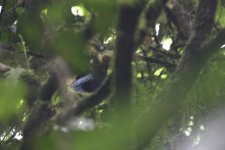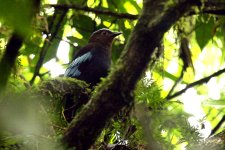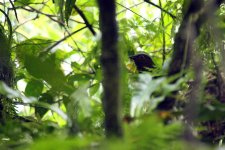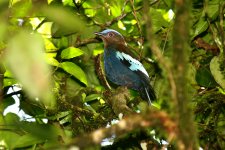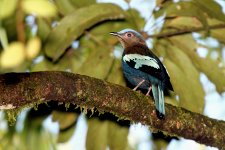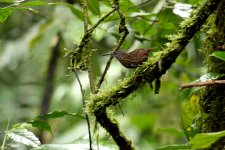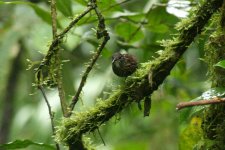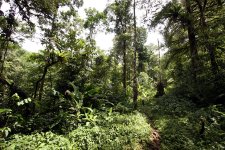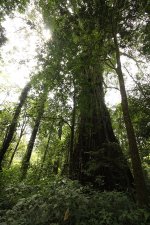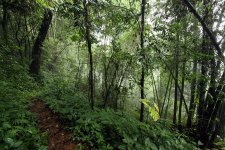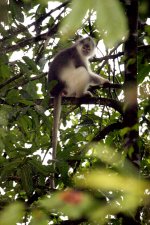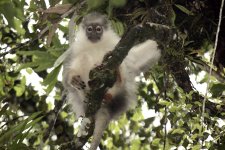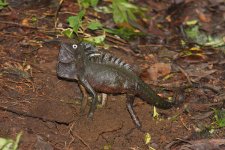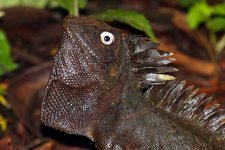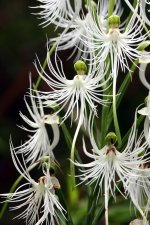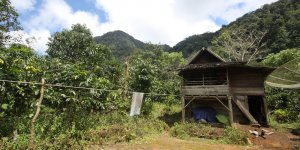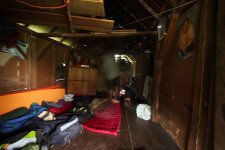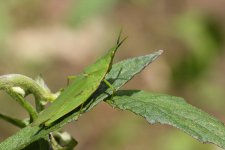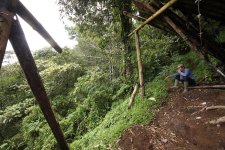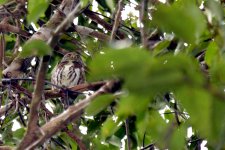Sumatran Cochoa continued… (yes Im making the most of it 
We birded along the main trail all morning, steadily heading up hill. As we reached the ridgeline late morning we paused to have a break. I took this opportunity to slip off down the other side of the hill to record some Siamang Gibbons that were loudly calling away down slope. As I left the other three I said Id give them a signal if I had anything worthwhile, hoping they too would reciprocate. I wound my way down from the summit into a stretch of bamboo dominated forest on steep slopes, with the trail being forced into a short set of switchbacks to ascend to its summit point. I stopped and sorted out my sound recording equipment and then pressed record on the machine to get some more Gibbon calls. About a minute and a half into the recording a dark bird flew along the side of the hill inside the bamboo canopy and landed out of sight to my right. I thought this was definitely interesting; it was a chunky thrush sized dark bird, with a different jizz from everything else seen earlier …could it possibly be?? Still recording, incase it turned out to be either unfindable or something common, I sidestepped along the trail about five paces to where the bird landed. I put up binos using one hand, mic in the other, and could see, partially obscured, a stonking male Sumatran Cochoa staring back! Uttering a few choice swear words to myself, I abandoned the microphone, dangling somewhere on me, and picked up my camera to get a record shot, which was also dangling on my shoulder. Having been the sole observer of an unphotographed pitta the day before, even the most honest of folk would be subject to other birders enquiring minds of slight disbelief if this one also disappeared. I couldn’t get auto focus to work so put it on manual and got the worst of record shots (Photo 1), no doubt suffering from my shaking hands as well as the low light, but it does show my first views of the bird. I then side stepped as gingerly as possible to get the bird non obscured, and then rattled off a series of about five photos in quick succession (one being Photo 2).
The next step was to get the others on it. I side stepped further along the trail, and then back stepped, keeping my eyes on the bird rather than where I was going, slowly moving backwards trying as hard as possible not to spook it. On reaching the first switchback and then loosing sight of the bird round the bend I legged it up the hill and whistled to the others who were not too far away. Martin was first down the trail, followed by Holger and as they came into view I called out Cochoa to them. Their faces were probably a mixture of fear of potentially missing a major sighting and excitement that round the corner was a mega bird. We all got to the point of where I had left the bird and it was not sitting out in the place I had last seen it. A moments panic that it had flown off was however quickly extinguished as we picked the bird up further back on the same tree, mostly obscured with just his head visible (Photo 3).
After the first few seconds of everyone getting onto a viewing position and getting some photos, we could all relax and soak in the beauty of the bird. It even hopped back out into full view and allowed us to watch it preening and loafing around. Between us we took many photos, my favourite two are with flash (Photos 4 & 5) as it brings out the blue colours on the breast & belly and lights up the bird better than non-flash in the dark sub canopy, but it does provide a slightly artificial view of the bird compared to real life. The bird was on view for just under three hours (!) and spent the most of that time sitting quietly and still just under the canopy of the forest. Im sure that without it being near the path, or me having luckily been in the right position to pick up the bird as it flew in, we could easily have walked right past it.
This was not the end of our Cochoa experience either, the final day, on our walk out we disturbed the bird again in the same general area right above the path this time. It picked its way quickly to the canopy this time and flew towards the ridgeline. As we descended for our final time of the trip the Cohcoa called from high up on the ridgeline for about 45 minutes, the call floating around us as we wound our way down the pathway out of the forest.
I didn’t record the Cochoa calling, but I did after our three hour stint with it, go back to recording the Siamang Gibbons, which were still going for it down slope. The unedited recording is here. At just over 1 min you can hear the whoosh of a Bushy-crested Hornbill wingbeat that flew into the tree next to where I was recording, followed by the clatter of my camera and mic colliding as I unsuccessfully attempted a photo before it flew off again (it had landed only 5m away). Not very professional on the sound recording front.
We birded along the main trail all morning, steadily heading up hill. As we reached the ridgeline late morning we paused to have a break. I took this opportunity to slip off down the other side of the hill to record some Siamang Gibbons that were loudly calling away down slope. As I left the other three I said Id give them a signal if I had anything worthwhile, hoping they too would reciprocate. I wound my way down from the summit into a stretch of bamboo dominated forest on steep slopes, with the trail being forced into a short set of switchbacks to ascend to its summit point. I stopped and sorted out my sound recording equipment and then pressed record on the machine to get some more Gibbon calls. About a minute and a half into the recording a dark bird flew along the side of the hill inside the bamboo canopy and landed out of sight to my right. I thought this was definitely interesting; it was a chunky thrush sized dark bird, with a different jizz from everything else seen earlier …could it possibly be?? Still recording, incase it turned out to be either unfindable or something common, I sidestepped along the trail about five paces to where the bird landed. I put up binos using one hand, mic in the other, and could see, partially obscured, a stonking male Sumatran Cochoa staring back! Uttering a few choice swear words to myself, I abandoned the microphone, dangling somewhere on me, and picked up my camera to get a record shot, which was also dangling on my shoulder. Having been the sole observer of an unphotographed pitta the day before, even the most honest of folk would be subject to other birders enquiring minds of slight disbelief if this one also disappeared. I couldn’t get auto focus to work so put it on manual and got the worst of record shots (Photo 1), no doubt suffering from my shaking hands as well as the low light, but it does show my first views of the bird. I then side stepped as gingerly as possible to get the bird non obscured, and then rattled off a series of about five photos in quick succession (one being Photo 2).
The next step was to get the others on it. I side stepped further along the trail, and then back stepped, keeping my eyes on the bird rather than where I was going, slowly moving backwards trying as hard as possible not to spook it. On reaching the first switchback and then loosing sight of the bird round the bend I legged it up the hill and whistled to the others who were not too far away. Martin was first down the trail, followed by Holger and as they came into view I called out Cochoa to them. Their faces were probably a mixture of fear of potentially missing a major sighting and excitement that round the corner was a mega bird. We all got to the point of where I had left the bird and it was not sitting out in the place I had last seen it. A moments panic that it had flown off was however quickly extinguished as we picked the bird up further back on the same tree, mostly obscured with just his head visible (Photo 3).
After the first few seconds of everyone getting onto a viewing position and getting some photos, we could all relax and soak in the beauty of the bird. It even hopped back out into full view and allowed us to watch it preening and loafing around. Between us we took many photos, my favourite two are with flash (Photos 4 & 5) as it brings out the blue colours on the breast & belly and lights up the bird better than non-flash in the dark sub canopy, but it does provide a slightly artificial view of the bird compared to real life. The bird was on view for just under three hours (!) and spent the most of that time sitting quietly and still just under the canopy of the forest. Im sure that without it being near the path, or me having luckily been in the right position to pick up the bird as it flew in, we could easily have walked right past it.
This was not the end of our Cochoa experience either, the final day, on our walk out we disturbed the bird again in the same general area right above the path this time. It picked its way quickly to the canopy this time and flew towards the ridgeline. As we descended for our final time of the trip the Cohcoa called from high up on the ridgeline for about 45 minutes, the call floating around us as we wound our way down the pathway out of the forest.
I didn’t record the Cochoa calling, but I did after our three hour stint with it, go back to recording the Siamang Gibbons, which were still going for it down slope. The unedited recording is here. At just over 1 min you can hear the whoosh of a Bushy-crested Hornbill wingbeat that flew into the tree next to where I was recording, followed by the clatter of my camera and mic colliding as I unsuccessfully attempted a photo before it flew off again (it had landed only 5m away). Not very professional on the sound recording front.
Attachments
Last edited:




